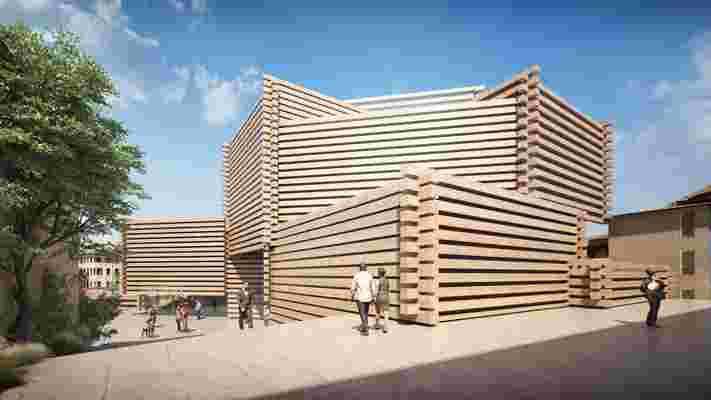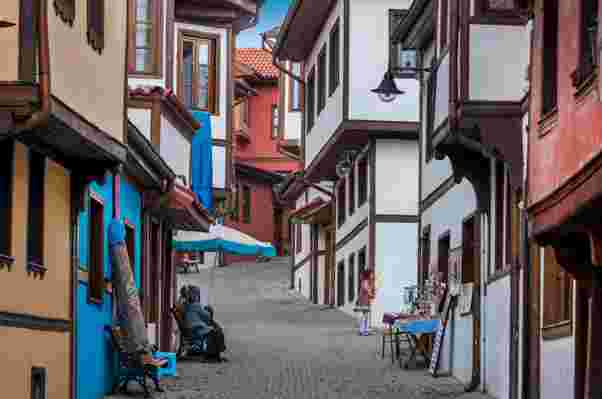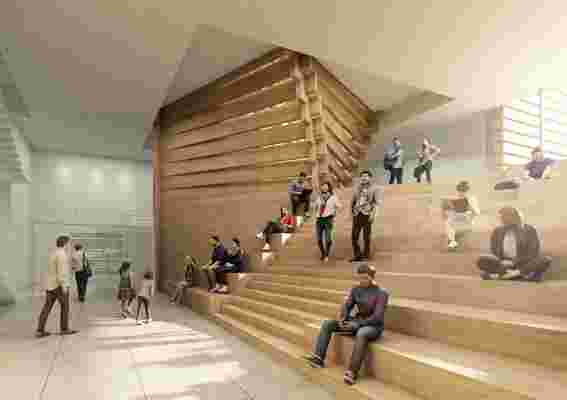Odunpazari, a town in Turkey located roughly four hours southwest of Istanbul, is known largely for the historical timber market it once housed—the name itself translates to "wood market." As the oldest settlement in the Eskişehir province—it dates back to the Seljuk and Ottoman period, and is listed on UNESCO's Intangible Cultural Heritage List—the university town has long been revered more for its past than its contemporary offerings. But thanks to the new Odunpazari Modern Museum designed by Kengo Kuma and Associates , the town is ushering in a new cultural era.
To integrate both Odunpazari's rich historical past and a new vision for the future, Kuma and team designed a structure comprised of interlocking wooden boxes stacked atop one another. Thin strips of wood, sourced both locally and from afar, cover the glass and concrete base; one might be apt to mistake them for giant popsicle sticks. "When most people think of Turkey, they think of the blue mosque, the Hagia Sofia , of stone and other heavy materials; I wanted to change the image of Turkey by using natural materials, like wood, for our museum," says Kuma. "Modern architecture in the International Style, which was dominated by concrete and steel, severed tied between human beings and their places. By turning to wood and natural materials available from the place again, we seek ways of sustainable life on earth."

Along with surrounding museums including the Museum of Modern Glass Art and the Museum of the History of the Republic, OMM's addition will create a new public square for local community to enjoy.
Inspiration for the building's design came from Kuma's first visit to Eskişehir, as he took in Odunpazari's traditional Ottoman wooden houses that are unique to the area and found all over the district, whose cantilevered upper levels add an unexpected texture to the meandering small streets. "The town is very different than Istanbul—it's a totally different scale, and type of materiality. I wanted to translate that sense of intimacy and warmth to the building, and create a harmony with the neighboring architecture," says Kuma.

Traditional 19th-century Ottoman architecture in Odunpazari.
But more than just a contemporary and modern art institution, OMM aims to engage the local community—not solely visitors to the museum. While it doesn't tower above any of the surrounding buildings, the structure's architecture is equally arresting through its use of scale and the sheer volume of space. There isn't one designated front or back; the design is multifaceted and egalitarian, and recognizable from all angles. Through a handful of interlocking boxes that shift outward from the center and grow in size as they reach the center, the design welcomes both museum visitors and the general public alike to gather in the surrounding plaza. "Stacked boxes at the street level is read in the scale of surrounding houses, and it grows taller towards the center of the museum to stand in the urban scape that announces itself as a new culture landmark of the area," says Yuki Ikeguchi, the partner from Kengo Kuma and Associates in charge of the project, in a statement.

An interior rendering of the light-filled museum.
The museum, whose opening has been pushed from June to September due to the recent political uncertainty in wake of the March elections, showcases works from the collection of Erol Tabanca, which features more than a thousand works from the 1950s through to the present day, with a heavy focus on Turkish artists. A permanent installation by Japanese bamboo artist Tanabe Chikuunsai IV anchors the atrium, which is flooded with light from above and permeates throughout the rest of the museum. Bringing nature into design is a signature of Kuma's designs, and OMM is no exception. "Through the wooden sticks I want to show that Turkey is very much connected with nature, ground, and heaven. The atrium is the most important; it's the spiritual core of the museum," he says.
